Author: Jasper De Maere, Outlier Ventures Translator: J1N, Techub News
Since March 2024, the cryptocurrency market has seen a sharp correction. Most Altcoins (tokens other than Bitcoin, Ethereum, etc.), especially some relatively mainstream Altcoins, have seen their prices fall by more than 50% from their highs, but this has not had much impact on newly listed tokens. By studying more than 2,000 token issuance cases, we found that the prices of native tokens of early-stage projects with financing scales of millions of dollars can remain stable and move independently of the market.
Summary
Based on the observation of the market from January to April, we found that the investment and financing market has a lag in responding to the rise and fall of the market, that is, a large number of investment and financing will emerge only one month after the market rises sharply.
This year, token issuance through public sales has dominated, accounting for 81% of all token issuances since the beginning of the year. There is not even a track with more private equity projects than public sales projects, which shows that public sales are strongly favored by the market.
Since the valuation data of each stage is too different after the projects complete different stages of financing, and because these projects often have subjective biases when disclosing information, it is impossible to draw meaningful conclusions from them.
Financing scale and track maturity
Web3 itself is not an industry, but a technology stack that is changing the entire industry. At the same time, no two tracks in Web3 are the same. The backgrounds of the founders are different and the blockchain solutions provided by the projects are different. Therefore, each track in Web3 has different requirements for capital. In order to make everyone more clear about the capital needs of each track, we combine the financing scale with the financing stage of each track, with a time range of early 2024 to August 11, and then get a chart:
X-axis: the stage of project financing.
Y-axis: Average financing amount of the project.
Bubble: The size of the bubble represents the number of financings of the project.
The diagonal line from the lower left to the upper right divides the yellow and blue areas. The blue represents the track with relatively less financing, and the yellow represents the capital-intensive track.
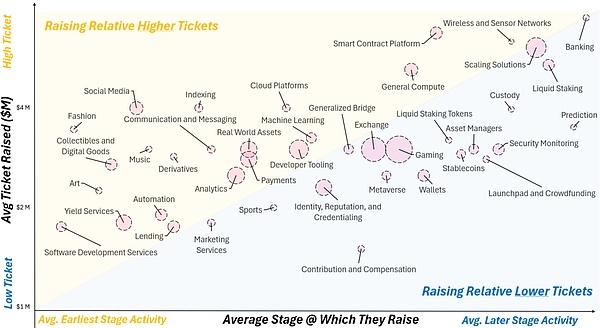
2024 Financing Stage and Scale Chart of Each Track
Token Financing
Based on the data from the beginning of the year to August 11, we studied a total of 375 projects, which either adopted a public-private hybrid token issuance model or used non-stablecoins for financing.
Over the past year, a total of 375 tokens were listed in the cryptocurrency market, of which 70 were privately funded and 305 were publicly sold. By making a chart of the number of tokens listed and the rise and fall of the Altcoin market value, we can see that the number of tokens listed and the increase in the Altcoin market value are positively correlated. When the Altcoin market value is on an upward trend, the number of tokens listed will rise sharply in the next month. In the past few months, due to many holidays and poor market performance, activities have decreased.
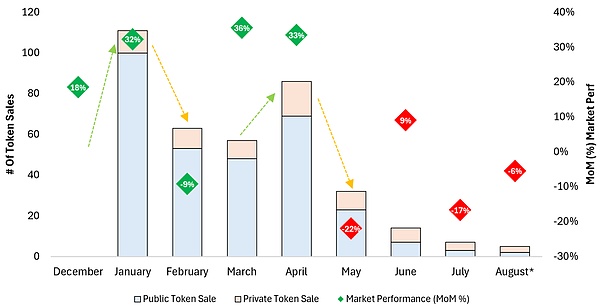
Comparison of the number of tokens listed and the rise and fall of the Altcoin market value
Further observation, we not only found that the number of tokens listed is related to the rise and fall of the Altcoin market value, but also found that the number of tokens listed through private placement is positively correlated with the rise and fall of the market. We think this is expected, because public offerings usually require project parties to make more preparations, and too long preparation time may lead to missing the market.
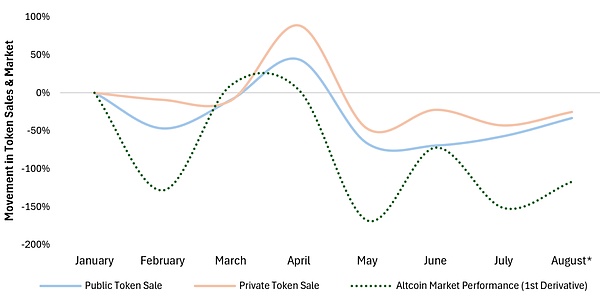
Number of token issuance activities and monthly Altcoin market value growth
We also analyzed the financing methods of the projects. About 81% of the newly listed tokens were public sales. So far this year, no track has more private sales than public sales.
On the X-axis, with the middle as the dividing line, you can see private sales on the left and public sales on the right. The Y-axis shows the median amount of financing, and the size of the bubble indicates the number of tokens listed.
There are 82 game projects, 44 exchange projects, 19 DeFi yield agreements, and 19 metaverse projects. These four tracks account for the majority of token issuance projects this year.
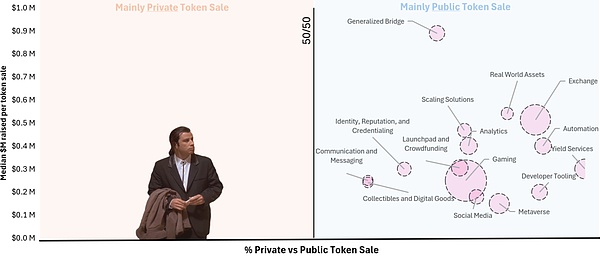
Relative share of public and private token issuance and median financing amount
Traditional venture capital
We studied 1,919 financings and analyzed the data of each financing stage. The final conclusions include:
Since 2024, we have counted the average financing size of each stage: Pre-Seed round $2.2 million, Seed round $4.9 million, Series A $19.8 million, and Series B $51 million.
Let's take a closer look at these numbers. We found that Seed rounds are the most active stage of financing, followed by Pre-Seed rounds. Interestingly, we found that fewer and fewer companies distinguish between the two rounds of financing, because sometimes the Seed round is replaced by the Private Round.
Next, we noticed many accelerator incubation programs. According to our observation, these incubation programs have increased compared to last year. This year, we have seen the birth of many new accelerators in Web3. But there is a problem with the data, which is the number of grants. I think the actual number of incubation projects is an order of magnitude larger than the statistical number. Therefore, grants are not considered financing.
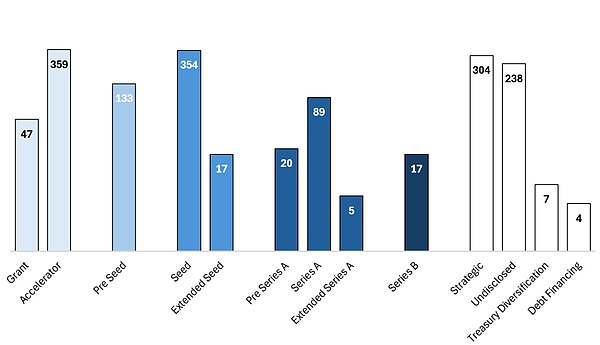
Different financing stages and amounts from the beginning of the year to date
Marking the financing amount data, we get the following figure. It is relatively common for project parties to choose not to disclose the financing amount, but if the data sample is large enough, the missing data can be inferred.
As shown below, the gray area is inferred data. In order to eliminate the huge impact of outliers, we adopted a conservative method to calculate the total by mixing the median and the average.
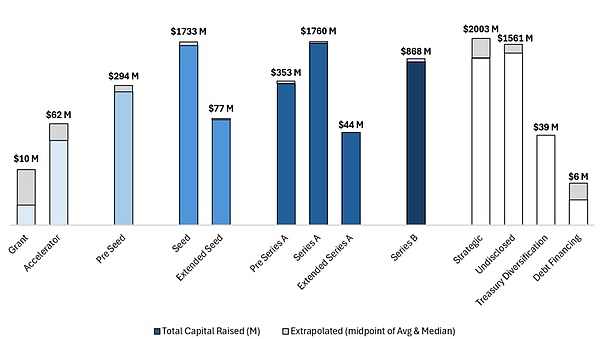
Total amount of funds raised at different stages
Using the above two charts, we further calculated the approximate average financing amount at each stage from the beginning of the year to date, that is, the simple total financing amount was divided by the number of financings. Although the results obtained are not accurate enough, they are consistent with the recommended analysis we provide to our peers.
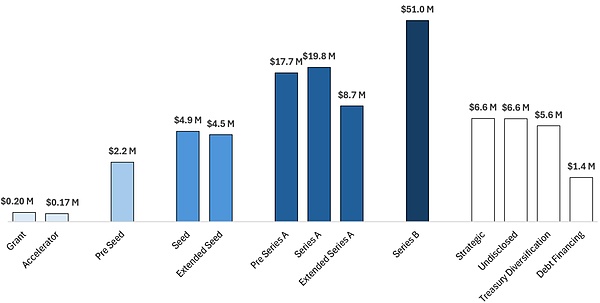
Average financing amount at each transaction stage
Finally, we studied the changes in the financing scale of Pre-Seed, Seed and A rounds over time. From the data, despite the market turmoil, the scale of Pre-Seed and Seed rounds is less affected by the market because these early projects focus on innovative fields.
In contrast, the A round is closer to or at the TGE stage, which requires the project party to prove the attractiveness of its product. Market corrections usually have a greater impact on later-stage investments, resulting in a decline in both financing activities and scale, which is the case in 2022.
The increase in early-stage financing this year (starting from January 2024) may be due to investors' belief that the market has shifted from the late stage of turbulence to the early stages of recovery, so the investment and financing market was booming at the beginning of the year.
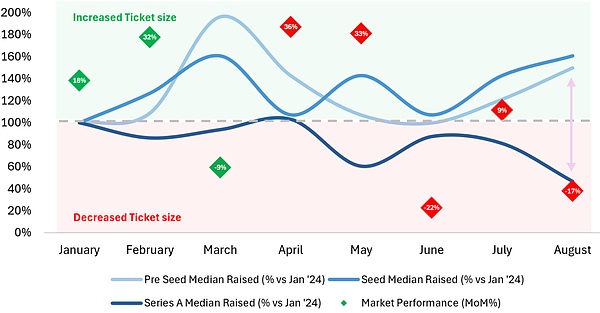
Compared with January, the change in financing scale at each stage
Data adjustment
Key information:
We report all financing data in the cryptocurrency industry from the beginning of 2024 to the present. However, there are some problems in the process of collecting data, which are explained below.
In our data, 1,392 companies will register their financing information in multiple channels at the same time, of which there are two situations:
The company has raised multiple rounds of financing in a year.
The company has raised both traditional venture capital and on-chain token financing.
The following are some of the most common financing combinations. The most common are accelerators and seed rounds, which makes sense because accelerators’ incubation programs help de-risk the project’s business model, and projects often choose to join accelerators when preparing for Pre-Seed or Seed rounds. We also see public token sale rounds being conducted at the same time as strategic or seed rounds, often at the same time as TGEs before or at launch. In addition, only four companies completed both seed and Series A rounds this year.
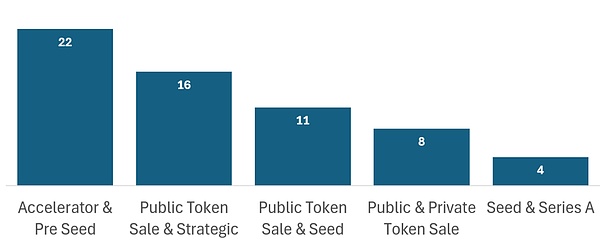
Various financing options and the number of adoptions
We highlight these trends to tell project founders that non-traditional financing structures are not uncommon, and we strongly recommend founders to combine traditional equity and token financing.
 Anais
Anais















